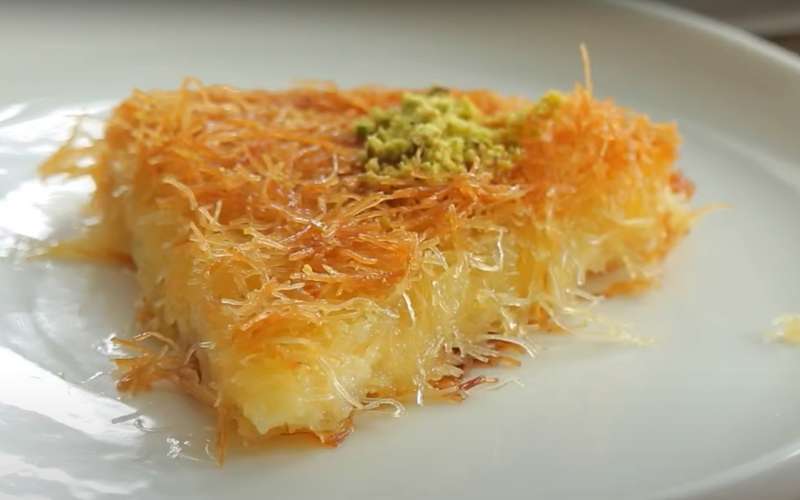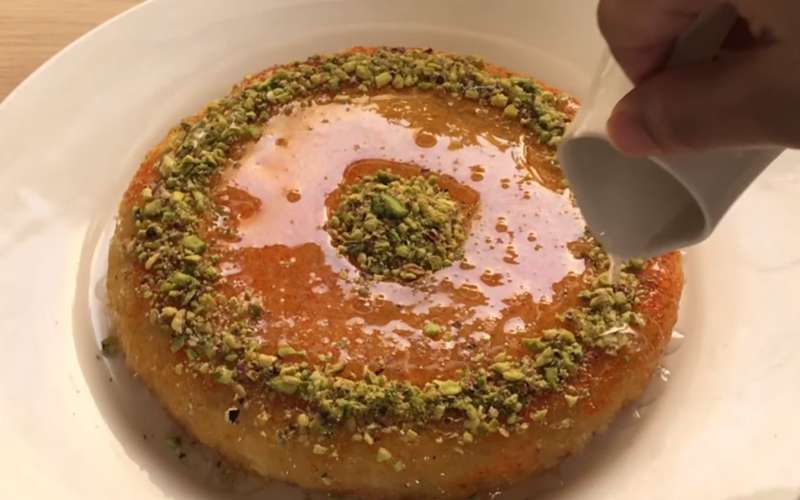Knafeh, also known as Kunafa, is a sweet and crunchy dessert.
There are different types of Knafeh, but my favorite is Palestinian Knafeh. The Palestinian Knafeh recipe is super easy to follow.
Mix 1 pound of finely cut shredded dough with 6 ounces of ghee. Grease a pan generously with more butter or ghee, and put half of the dough in it.
Spread a pound of “sweet” cheese evenly; Akawi is excellent, or you can use Mozzarella, Oaxacan with Ricotta, or even frozen “sweet cheese” from halal markets (don’t use halloumi).
Add the rest of the dough, seal it well, then bake at 400°F for 30-35 minutes.
Let it cool for about 5 minutes, carefully flip it onto a tray, soak it with a quarter, and sprinkle pistachios on top. Enjoy!
Knafeh is super popular in the Middle East and is often served at celebrations. People enjoy it a lot!
Required Ingredients
Here are the ingredients to make Knafeh Khishneh, the easiest and most preferred variety.
- Kataifi (Shredded Phyllo Dough): You can get this at most Middle Eastern grocery stores or order it online. It’s like shredded dough.
- Ghee: Melted Ghee is mixed with the shredded phyllo dough. It helps the dough stick together. Melted butter is another good alternative.
- Akawi Cheese: Akawi is used in Arab countries but is tough to find elsewhere. Don’t have Akawi cheese. Mozzarella cheese is a common and good substitute. Moreover, mozzarella is a stretchy cheese that works well as a substitute for Akawi cheese. You can also use Oaxacan mixed with Ricotta/cottage cheese or even the frozen “sweet cheese.”
- Syrup: Knafeh is sweetened with a simple sugar syrup. You’ll need sugar and water (and optionally a bit of lemon juice and rose water) to make the syrup. After baking, drizzle this syrup over the Knafeh. Add a pinch of rose water to your syrup for extra flavor if you have it.
Note: You can find the amounts needed in the recipe card at the end and change them based on how much you want to make.
Sometimes, restaurants use a special coloring (called Knafeh dye) to make their Knafeh look more orange. This gives it a deep orange color.
I usually don’t use any coloring to change the color of my food.
So, mine ends up being more yellowish and a bit golden. You can add some dye to the dough if you like the orange color.
How to Make Traditional Palestinian Knafeh (Kunafa) – Step by Step

Find the step-by-step process of making Palestinian Knfeh.
Step 01: Making the Dough
Mix flour, water, milk, sugar syrup, salt, and yeast to start.
Shape the dough into thin pieces, similar to spaghetti. Grind it and add Ghee
before roasting and filtering.
Step 02: Preparing the Cheese
Choose Nabulsi cheese for a traditional taste. Grind the cheese and sweeten it by soaking it in water multiple times.
Step 03: Layering and Cooking
Take a tray and spread some ghee on it. Then, layer the tray with the dough and cheese.
Feel free to use any big cake or baking pan you like. When layering the Knafeh, it’s best if it’s less than 1 inch tall.
Press down hard, preferably with the back of a measuring cup. Push some of it along the edges so the cheese doesn’t touch the pan directly.
The tighter you pack it, the crunchier the Knafeh will turn out.
Step 04: Cooking or Baking
Cook it for 5-7 minutes. You can cook it on a stove.
If you bake it in the oven, Preheat the oven to 400°F. Bake the Knafeh for about 30-35 minutes until it turns golden and crispy on the edges and bottom.
Then, leave it to cool and it should loosen from the edges of the pan.
Step 05: Flipping and Sweetening
Cover the tray with another tray and flip it. After that, add sugar syrup.
Do you want to learn the syrup recipe?
It is super easy!
Make the syrup by mixing sugar, water, and rosewater extract in a saucepan. Bring it to a boil and cook for 1-2 minutes until the sugar dissolves. Then, take it off the heat and let it cool down.
Step 06: Serving the Knafeh
Finally, the Knafeh is ready to be served.
I recommend pouring the syrup slowly and evenly over the Knafeh with a big spoon. You want it completely wet but not so much that the syrup spills everywhere.
After soaking, add chopped pistachios for decoration, slice it, and then serve! Knafeh tastes best when eaten warm or hot, so the cheese inside is gooey and melted.
Common Mistakes, Solutions, and Prevention During Palestinian Knafeh
Mistakes are common when preparing a food and Palestinian Knafeh is also no exception. Find the common mistakes, solutions and prevention from the below chart.
| Mistake | Solution | Prevention |
| Using homemade kataifi dough | Find pre-made kataifi dough at a Middle Eastern grocery store or online. | Plan ahead and purchase kataifi dough to ensure the right texture and appearance. Homemade versions might not give the iconic vermicelli-like top. |
| Milk and semolina filling not setting properly | Follow the recipe closely and ensure the correct proportions and cooking times for the milk and semolina filling. | Double-check the recipe and cooking instructions for the filling, and be precise in measuring the ingredients. |
| Using halloumi cheese | Use other cheese options like Mozzarella, Oaxacan mixed with Ricotta, or frozen “sweet cheese” from halal markets. | Read the recipe carefully and choose the recommended cheese types, avoiding halloumi for a better taste and texture. |
| Not soaking with qater immediately after flipping | Immediately soak the Knafeh with qater after flipping onto the serving tray. | Be attentive to the timing mentioned in the recipe and don’t delay in soaking the Knafeh to maintain the right moisture and consistency. |
How to Store and Serve Palestinian Knafeh

Palestinian Knafeh tastes best when served perfectly.
Serving Options
You can serve Knafeh in the baking dish or flip it onto a platter.
Either choice works. When serving, pour syrup over the baked Knafeh and sprinkle chopped pistachios on top for a tasty touch.
Storing Tips
Is there any left-over after serving to guests? Here are the storing and serving options to follow.
Storage: Keep the extra kunafa in a sealed container in the fridge for 3-4 days. After that, it will become too soft.
Freezing: I recommend freezing the unbaked Kunafa. Cover your baking tray with plastic wrap, combine the Kunafa, and freeze it until it’s solid.
You can use the plastic wrap to lift the Kunafa from the tray, wrap it again in another layer of plastic, and freeze it for up to three months.
Put it back in the baking tray before thawing (overnight), then bake it as instructed, adding a few minutes to the baking time if necessary.
Reheating: Warm up the Knafeh in the microwave in 15-20-second bursts for a soft texture or in the oven (slightly crisper) at around 360ºF/180ºC for 10-15 minutes until it’s warmed through.
Why is it Called Knafeh?
People aren’t sure where Kanafeh originally came from. Some think it comes from the Coptic Egyptian word “kenephiten,” which means bread or cake.
The earliest mentions are in stories from Egypt in the One Thousand and One Nights.
When the Jewish people moved around the Ottoman Empire, they picked up local recipes; when they moved elsewhere, they brought Knafeh.
The name Knafeh comes from the Egyptian word for “cake.” Israel and its neighbors have versions with slight name differences, like Kunefe or Kunafa.
Middle Eastern Knafeh: Cultural Significance
Knafeh is well-liked in the Middle East, especially in Syria and Lebanon, as well as in Turkey and Greece. But, the way it’s made can differ in each country.
The story of Knafeh goes way back to medieval times in the Middle East. It’s said that doctors created this dish for Islamic caliphs during Ramadan to ease their hunger.
People have been writing about it since the tenth century.
The original version mixes shredded phyllo dough with a soft sheep’s cheese like Nabulsi Akkawi.
They soak it all in a simple syrup. Even though people make it differently, layering the dough and cheese gives it a special mix of textures.
Knafeh is a lot like Baklava, often found together at markets in Israel. It’s crispy and creamy, satisfying more than just a sweet tooth.
While tourists might find it at markets, it’s usually a special occasion treat in most homes.
Innovators in cooking have taken the old recipe and brought it to the 21st century. Some chefs stuff the dough with ground meat, while others use vegan cashew cheese.
What began as a traditional Muslim dessert is now trendy in upscale restaurants worldwide. Even Trader Joe’s in America sold frozen Knafeh for a while. Pizza Hut Israel even had a Knafeh Pizza for a bit.
A famous restaurant in Acre, Israel, uses soft ricotta cheese in their Knafeh, mixing Italian and Israeli flavors.
Gaza’s Knafeh is special because it doesn’t have cheese. They use bulgur wheat instead of pastry dough and add cinnamon, nutmeg, and walnuts.
Another way to change up your Knafeh is by adding crushed pistachios. It gives the dessert a savory and crunchy touch, along with a burst of bright color.
FAQ
Do you prefer Kunafa hot or cold?
I’m used to having Kunafa when it’s hot – all creamy and super crunchy. While you can eat it warm, I don’t like it when it’s cold, especially if it’s filled with cream.
Is Knafeh similar to baklava?
Baklava and Kunafa are yummy desserts from the Middle East, each with its popularity.
Baklava has layers of phyllo pastry and chopped nuts, while Kunafa uses shredded phyllo dough or semolina pastry.
It’s filled with things like cheese, nuts, or cream. They’re both tasty but made in different ways!
Conclusion
So, there you have it – the delightful journey of Knafeh! Now that you know the ins and outs, why not dive into your kitchen and try?
It might seem like a challenge, but the sweet reward at the end is worth it.
Don’t forget to experiment, make it yours, and most importantly, share the joy – maybe snap a pic for the ‘gram!
Happy cooking!
Leave a Reply